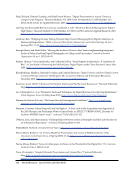SPEC Kit 329: Managing Born-Digital Special Collections and Archival Materials · 139
Rutgers University
RUcore. Archival Standards for Born-Digital Documents
http://odin.page2pixel.org/standards/latest/RUcoreStandards-BornDigitalDocuments.pdf
IBB • RUcore Preservation Standards • Born Digital Documents Rev: 8/9/2010
Page 3 of 3
built-in capability to accurately “export” a document into a PDF version. This capability should
be used when available to generate a faithful PDF file. Otherwise, the PDF/A can be generated
using software available on RUcore platform.
Why PDF/A: An established standard to augment object datastreams
Although Portable Document Format has its roots in a proprietary system, recent efforts have
proven fruitful – mainly thanks to Adobe, the creator of the file format – to have it recognized as an
archival standard. PDF/A is defined by ISO 19005-1:2005, an ISO Standard that was published on
October 1, 2005. According to the Library of Congress: “PDF/A is suggested as a preferred format for
page-oriented textual (or primarily textual) documents when layout and visual characteristics are more
significant than logical structure.”1
The openness of this format has permitted a widening selection of software solutions to create
archival PDFs from most digital documents. As indicated earlier, PDF “export” capability now exists
on the market leading packages. Additionally, some computing platforms, namely OS X for Apple Mac
computers and Linux environments, have a similar “print to PDF” feature standard as part of the
operating system. Finally, free viewers exist for desktop and mobile computing platforms. This heavy
documentation and wide accessibility make PDF/A a natural choice for acting as platform-independent
method for preserving and making accessible born digital documents, without requiring users to
purchase expensive, proprietary software to view the content.
Review provisions for special cases
The diversity that exists among born digital document formats virtually guarantees that a single
standard will not address all use cases. In particular, this standard will not be well-suited to born digital
documents that are formatted in such a way that a page-based presentation approach would be
detrimental. In such a case, a review of how these documents were constructed will have to be
undertaken, and the Digital Data Curator will need to consult the Cyber Infrastructure Working Group
(CISC) and related subgroups on the best way to proceed.
1 http://www.digitalpreservation.gov/formats/fdd/fdd000125.shtml
Rutgers University
RUcore. Archival Standards for Born-Digital Documents
http://odin.page2pixel.org/standards/latest/RUcoreStandards-BornDigitalDocuments.pdf
IBB • RUcore Preservation Standards • Born Digital Documents Rev: 8/9/2010
Page 3 of 3
built-in capability to accurately “export” a document into a PDF version. This capability should
be used when available to generate a faithful PDF file. Otherwise, the PDF/A can be generated
using software available on RUcore platform.
Why PDF/A: An established standard to augment object datastreams
Although Portable Document Format has its roots in a proprietary system, recent efforts have
proven fruitful – mainly thanks to Adobe, the creator of the file format – to have it recognized as an
archival standard. PDF/A is defined by ISO 19005-1:2005, an ISO Standard that was published on
October 1, 2005. According to the Library of Congress: “PDF/A is suggested as a preferred format for
page-oriented textual (or primarily textual) documents when layout and visual characteristics are more
significant than logical structure.”1
The openness of this format has permitted a widening selection of software solutions to create
archival PDFs from most digital documents. As indicated earlier, PDF “export” capability now exists
on the market leading packages. Additionally, some computing platforms, namely OS X for Apple Mac
computers and Linux environments, have a similar “print to PDF” feature standard as part of the
operating system. Finally, free viewers exist for desktop and mobile computing platforms. This heavy
documentation and wide accessibility make PDF/A a natural choice for acting as platform-independent
method for preserving and making accessible born digital documents, without requiring users to
purchase expensive, proprietary software to view the content.
Review provisions for special cases
The diversity that exists among born digital document formats virtually guarantees that a single
standard will not address all use cases. In particular, this standard will not be well-suited to born digital
documents that are formatted in such a way that a page-based presentation approach would be
detrimental. In such a case, a review of how these documents were constructed will have to be
undertaken, and the Digital Data Curator will need to consult the Cyber Infrastructure Working Group
(CISC) and related subgroups on the best way to proceed.
1 http://www.digitalpreservation.gov/formats/fdd/fdd000125.shtml










































































































































































































